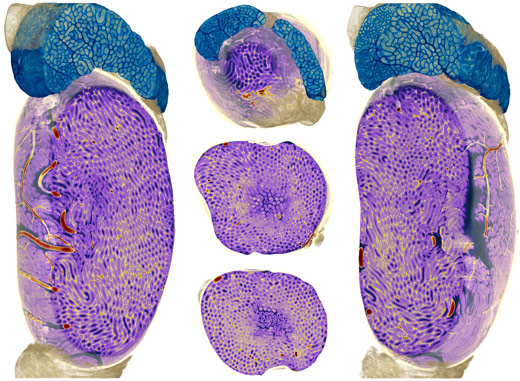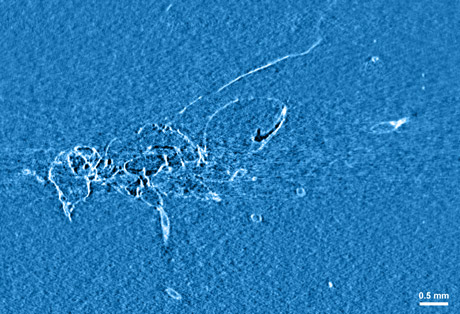- Home
- News
- General News
- High contrast, high...
High contrast, high resolution CT scan with reduced dose
04-06-2012
Soft tissue can be imaged with incredible detail using X-rays thanks to a new low dose CT scan technique.
Share
Jointly released by ESRF, TU München and Synchrotron SOLEIL
Scientists have developed an X-ray imaging method that could drastically improve the contrast of computed tomography (CT) scans whilst reducing the radiation dose deposited during the scan. The new method is based on the combination of the high contrast obtained by an X-ray technique known as grating interferometry with the three-dimensional capabilities of CT. It is also compatible with clinical CT apparatus, where an X-ray source and detector rotate continuously around the patient during the scan. The results of their research are published in Proceedings of the National Academy of Sciences (PNAS) dated 4-8 June 2012.
The main author of the paper is Irene Zanette from the European Synchrotron Radiation Facility ESRF (Grenoble, FR) and Technical University of Munich TUM (DE), and the team also comprises scientists from the Paul Scherrer Institute PSI (Villigen, CH), the Karlsruhe Institute of Technology KIT (DE), and Synchrotron SOLEIL (Gif-sur-Yvette, FR).
The conventional way of producing X-ray images is to shine an X-ray beam on the investigated object and measure the transmitted intensity behind it. This is the method that W.C. Röntgen developed in 1895, just after he discovered X-rays. To the present day, it is commonly used, for example, in hospitals and for security screening at airports. However, since this technique relies on variations in the absorption of X-rays by the different constituents of an object, it also has severe limitations notably in medical X-ray imaging where cancerous and healthy soft tissue often do not show enough contrast to be clearly distinguished.
In the past years, a lot of effort has therefore been put into the development of new X-ray imaging techniques that do not rely solely on absorption but increase the contrast through the observation of other types of interaction between X-rays and matter.
Of these new methods, a very promising one is the so-called “X-ray grating interferometry”, in which microstructures, gratings developed at PSI and KIT, serve as optical elements for X-rays. The setup for this contrast-enhancing technique is simple and compact, and it can be combined with computed tomography (CT) X-ray scanners to yield virtual slice images and full 3D information of an object. Over the past decade, grating interferometry has been constantly improved, with a focus on medical applications.
The team of scientists has now made an important step towards clinical implementation of this technique – a new measurement protocol called “sliding window” technique. “We wanted to shorten the gap between the potential offered by this extremely powerful technique and its application in the biomedical field. Our sliding window method reduces the dose and acquisition time and makes grating interferometry compatible with the continuous rotation of the gantry used in clinical CT”, says Timm Weitkamp from Synchrotron SOLEIL.
Grating interferometry uses, in addition to information on absorption, measurements of X-ray phase changes to produce “differential phase contrast” images. Density differences of only 0.5 mg/cm3 can be discerned using grating-based phase contrast.
To demonstrate the exceptional resolution of the new technique, various soft tissue body parts of a small mammalian specimen, a rat, were imaged. Within the tests, rendered in 3D, minute details are visible such as the individual seminiferous tubules, tiny tubes in which sperm cells are formed. “These structures are simply invisible in standard CT, even in high-resolution setups – not only because of their tiny size, but even more so because they hardly give any contrast”, explains Zanette, who was recently presented the ESRF Young Scientist Award for her work.
In addition to phase contrast, grating interferometry can also yield so-called “dark-field” tomography images. These show the presence of sub-pixel-size structures in the object, such as fibres, cracks or nanosized pores. In the study now reported in PNAS, wings of a wasp fossilised in amber – mostly invisible in previous X-ray investigations of the same specimen – were revealed in their full length with the dark-field signal. These results encourage the use of dark-field imaging not only in palaeontology and materials science, but also in the medical field, for example to reveal minuscule cracks in bones or small fibres in soft tissue.
The complementarity of the image signals accessed with grating interferometry and the new simple and fast acquisition procedure make grating interferometry an attractive technique for high-sensitivity imaging in the biomedical field, in materials science and in palaeontology, and possibly also in future hospital CT scanners.
Reference
I. Zanette, M. Bech, A. Rack, G. Le Duc, P. Tafforeau, C. David, J. Mohr, F. Pfeiffer and T. Weitkamp, Trimodal low-dose X-ray tomography, Proc. Natl. Acad. Sci. USA 109, 10199–10204 (2012).
Top image: X-ray imaging with microscope like detail.





